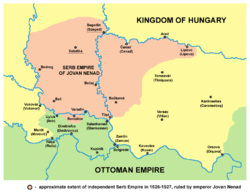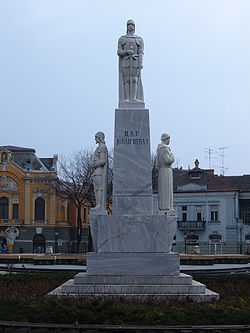Jovan Nenad
| Jovan Nenad | |
|---|---|
 Illustration | |
| Reign | 1526-1527 |
| Born |
ca. 1492 Lipovo, Banat of Severin, Kingdom of Hungary (now Romania) |
| Died |
26 July 1527 Sedfal field, near Szeged |
Jovan Nenad (Serbian Cyrillic: Јован Ненад; ca. 1492 – 26 July 1527), known as the Black[a] was a Serb military commander in the service of the Kingdom of Hungary who took advantage of a Hungarian military defeat at Mohács and subsequent struggle over the Hungarian throne to carve out his own state in the southern Pannonian Plain. He styled himself emperor (tsar).
Jovan Nenad is attributed by Serbian historians as the founder of Vojvodina and the leader of the last independent Serbian state before the Ottoman conquest.
Life
Origin
A Serb, he was born ca. 1492 in Lipova near the Mureş River in northern Banat (today in Romania). Other facts about his origins are uncertain; he himself claimed to be "a descendant of Serbian and Byzantine rulers", although other contemporaries thought that he was descending of the Serbian despots or that he was a man of low rank.[1] He was of medium height, slender, and highly moral and pious.[2]
Career
In the Battle of Mohács on 29 August 1526, the Ottoman Empire destroyed the army of Hungarian-Czech King Louis Jagellion, who was killed on the battlefield. After this battle, the Kingdom of Hungary became divided in three parts: Royal Hungary in the north and west became a Habsburg province, Transylvania in the east became an independent state, while the former central and southern parts of the Kingdom of Hungary were absorbed by the Ottoman Empire.
As King Louis had no children, Hungary was divided into two parties: one elected John Zápolya, a respected Hungarian noble, while the other declared for the King of Hungary a Habsburg, Ferdinand, Louis' brother-in-law. A part of this struggle was the leader of Serb mercenaries, Jovan Nenad, whom his contemporaries called "Black Man" because of a strange birthmark which many considered a divine mark: "he had a black stripe, one finger wide, starting at the right temple of his head and running in a straight line over his body down to his right foot".[1]
Right after the battle of Mohács, he appeared between Tisza and Danube as a leader of a Serb regiment, and for a short time, he drove Ottomans from Bačka and started to rule it, as well as parts of Banat and Syrmia where he attempted to create a state. He first sided with the Zapolyai and then with the Habsburg pretender after the Hungarian King refused to acknowledge his rule. After the defeat of a Transylvanian army sent to evict him, he rose to the peak of his power and Jovan Nenad styled himself emperor.
He named Radoslav Čelnik the general commander of his army, while his emissaries to foreign rulers were a Franciscan from Ilok Fabijan Literat and Ivan Dolić of Irig, the castellan of Bač. His treasurer and palatine was Subota Vrlić, a Serbian noble from Jagodina. Besides his army, the emperor also organized a guard numbering 600 soldiers. His army grew by drawing Serbs from Ottoman territory, Vlachs from Banat and Transylvania, and also some Roman Catholics, and by the beginning of 1527, it numbered around 15,000 men. It is believed that the cooperation of Orthodox and Catholic Slavs was the key of his later success. By the time of the reign of Jovan Nenad, Serbs had already considerable populations in the southern Pannonian Plain, most notably in the Danube and Tisa regions.

At first, Jovan Nenad supported Zápolya, but Hungarian nobles, whose lands in Bačka he had taken, estranged Zápolya from him, so in the beginning of 1527, he switched to Ferdinand. After the danger from the Ottomans passed, the Hungarian nobles and peasants from Bačka who had fled afore the Ottomans, started to return to their homes, but Nenad did not allow them to settle in Bačka again. He told them, "I found this land empty and took it with my people." The Hungarians answered that they had to flee from the land because of fear of the Ottoman Sultan. Nenad replied, "And I was the one who abducted this land from him. The coward Hungarians, you cannot hold this land because the Ottoman soldiers will for one night capture you and shunt you to Belgrade in bondage. So, you do not know what you ask."
Jovan Nenad considered struggle around the Hungarian throne just a temporary occupation, his primary task being the fight against Ottomans for the liberation of Serb lands. In the first half of 1527, Ferdinand was outside of Hungary, preparing for what would become the Hungarian campaign of 1527–28 to fight Zápolya. During that time, King Zápolya sent armies after Jovan Nenad, wishing to settle his internal affairs before Ferdinand could return to Hungary.
Underestimating Nenad's strength the king first sent a troop of 300 knights, led by László Csáky. He was defeated by Jovan Nenad in early April, and Csáky himself was captured and executed after the skirmish. After the murder of Csáky, an army was dispatched, led by the Voivode of Transylvania, Péter Perényi. It was defeated by in late April near Tiszaszőlős (Battle of Szőlős) on the banks of the Tisza river. Finally, a second army, which encompassed the entire strength of Transylvania and upper Hungary, led by Perényi and Bishop Czibak decisively defeated Jovan's army in the Battle of Sződfalva, killing around 8,000 of his men.
In an attempt to unite with the forces of Ferdinand, Jovan Nenad was severely wounded in Szeged. In his retreat towards Senta, he was intercepted and murdered in the village of Tornjoš. Jovan Nenad's head was delivered to the Hungarian King and soon after his death the remainder of his army dispersed, which was the end of Jovan Nenad's liberation movement.
After Jovan Nenad's death, general commander of his army, Radoslav Čelnik, led the remains of the army to Ottoman Syrmia, where he ruled until 1530 as Ottoman vassal.
Legacy

As time passed, Jovan Nenad became a mythical figure to the Serbs. Many Serbian historians consider him the founder of contemporary Vojvodina, although in reality his insurrection was too short-lived and his reign too tumultuous to have a lasting impact. Subotica, the province's second largest city (which was once his capital) erected a monument to him bearing the inscription "Your thought has prevailed" (Твоја је мисаo победила/Tvoja je misao pobedila).
In popular culture
In the 1942 Hollywood film, Cat People, a small statue of Jovan Nenad (albeit referenced as "King John of Serbia"), plays a central role in developing the underlying mythological basis of the film's plot. The statue is of "King John" on horseback, holding up an impaled cat on his sword.
See also
Part of a series on the |
||||||||||||||||||||||
|---|---|---|---|---|---|---|---|---|---|---|---|---|---|---|---|---|---|---|---|---|---|---|
| History of Serbia | ||||||||||||||||||||||
 | ||||||||||||||||||||||
|
||||||||||||||||||||||
|
||||||||||||||||||||||
|
Early modern
|
||||||||||||||||||||||
|
||||||||||||||||||||||
|
||||||||||||||||||||||
| Timeline | ||||||||||||||||||||||
| Serbia portal | ||||||||||||||||||||||
- Radoslav Čelnik, his successor
- Starina Novak (1530s-1601), hajduk leader
- List of Serbian rulers
- List of rulers of Vojvodina
- Serbs of Vojvodina
- Raci (ethnonym)
Annotations
References
- ↑ 1.0 1.1 Ćorović 2006
Za Zapolju se izjasnio i "car" Jovan Nenad, jedna neobična i još uvek misteriozna ličnost, koja se pojavila u ovaj mah među Srbima. On je izbio na površinu posle turskog povlačenja, koje je u južnim oblastima ostavilo pravu pustoš. Među srpskim beguncima, koji se behu sklonili u Gornji Banat izbi oko Lipove taj mrki i hrabri čovek, za koga niko nije pravo znao ni ko je ni odakle je. On se sam izdavao za potomka srpskih i vizantiskih vladara i uzeo je naziv cara. Kao unapred obeležen nekom višom silom za nešto neobično ljudi su nalazili to, što je on imao "na telu jednu crnu prugu u širini jednog prsta, koja je počinjala kod desne slepoočnice i išla u pravoj liniji sve do stopala desne noge."
- ↑ Istorisko društvo NR Srbije; Istorisko društvo, Novi Sad; Stanoje Stanojević (1930). Glasnik 3. p. 137.
Sources
- Dželetović, Veselin (2007). Јован Ненад. Поета. ISBN 978-86-86863-00-3.
- Ćorović, Vladimir (2001), "Srbi pod tuđom vlašću", Istorija srpskog naroda
- Ćorović, Vladimir (2006). Историја Срба. Дом и школа.
- Dušan J. Popović (1990). Srbi u Vojvodini. Matica srpska.
- Fedor Nikić (1928). Car Jovan Nenad.
- Aleksa Ivić (1929). Istorija srba u Vojvodini. Izdanje matice srpske.
External links
- (Serbian) Još jednom o caru Jovanu Nenadu
| ||||||||||||||||||||||||||||||||||||||
| Wikimedia Commons has media related to Jovan Nenad. |
|